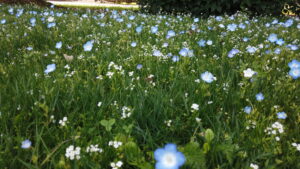Ten thousand: that’s how many types of grass exist in the world, and they come in a wide range of sizes. In making my point, grass is common and can be found just about everywhere. Grasses provide many benefits, including conserving water and helping to clean the air; keeping homes cooler; and serving as a source of food for people and livestock. Despite these benefits, it seems that many who plant grass seed and even those who sell it don’t see the value in caring for it as you would other crops, such as vegetables.
From my perspective, there are two primary parties at play — end-users and the seed industry. Let’s start with the end-users. Customers have high expectations when they plant grass seed, as they should, but most aren’t willing to put in the work. Customers expect perfection with no effort — instant gratification. They don’t realize that it takes weeks and months to get a yard looking like the ones on television.
They fail to understand that seed is a living thing that must be cared for. If you don’t water and fertilize it, the seedlings will shrivel up and die.
In the eyes of the customer, the problem is always with the seed. To help protect ourselves from claims such as this, we at The CISCO Companies keep samples on file for two to three years. When we send it off to the lab, if it comes back with a 93 percent germination rate, you know the problem is not the seed.
There’s also a misunderstanding that all grass varieties are the same. They might not recognize that some varieties, such as bluegrass, naturally grow slower. Additionally, some people use seed in a number of different areas that they shouldn’t.
As you can see, there are several factors working against us. As an industry, we need to do a better job of educating end-users about the benefits of grasses, help them to understand that not all grasses are the same, and work to deliver increased value to each customer. I realize this does not come without its challenges, but if we did a better job of educating consumers, the entire industry would benefit.
Ninety-nine percent of problems are related to weather or because the customer didn’t follow instructions. There’s this mindset that they can just throw the seed out and walk away. We have to change that.
Farmers too have not been as diligent in caring for the seed once it’s been planted. However, in the past five to 10 years, farmers have become more business minded, which has changed their buying approach. Now, they’re looking to purchase more quality products. We’ve found, that like many other products, if a customer pays a premium, he is more likely to take better care of it. Think of how you might treat a brand new car fresh out of the factory versus an old beater. You’ve got to take care of it and not just the first year.
Avoid Selling Cheap Seed
When it comes to the industry, it’s clear that new products hitting the market are driven by end-users. As of late, there’s been quite a bit of research on farm seed. We’ve also been working on new clovers and orchardgrass. Two of those end-users are the dairy and horse industries, which have consolidated, but they demand better products.
Look at the corn and soybean sectors. Companies have invested billions of dollars; they are not going to sell seed on the cheap. For the system to work, every-body has to make money. Over the years, it’s been a tragedy that companies have been reluctant to add value to grass seed because someone else with something similar will undercut you or the fear of not being able to get a return on your investment. The grass seed industry is extremely competitive and, in general, we all have similar products.
The thinking within our industry is that if I sell for a quarter cheaper, I might sell a million pounds more. It’s about moving quantity, not quality. This too is a mindset that needs to change. Grass seed has value, and we as an industry must learn to sell its attributes, whether it grows better in a specific climate or it has no weed seed. How much value does that add? A 10 percent margin increase could mean a lot. We’ve tried to create value here with our products, providing better seed. We even help retailers market it.
I’ve been in the business for 25 years, and I would love to see the seed industry supply more high quality seed. If we as an industry can add value to grass seed and change this mindset we’ve been stuck in for decades, we will all rise with the tide.













